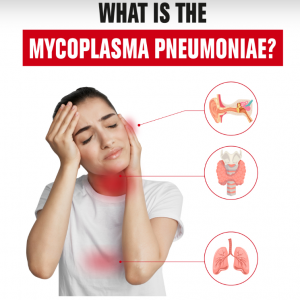Mycoplasma Pneumoniae Infection: Symptoms, Diagnosis, and Prevention
Introduction
In recent years, Mycoplasma pneumoniae infections have been on the rise worldwide, particularly among children and adolescents. As an atypical pathogen, M. pneumoniae causes a variety of respiratory symptoms that can be easily confused with other respiratory illnesses. Therefore, understanding its transmission, clinical manifestations, diagnostic methods, and prevention strategies is crucial. This article provides a detailed overview of Mycoplasma pneumoniae infection to raise public awareness and promote effective prevention and treatment measures.
1. What is Mycoplasma Pneumoniae?
Mycoplasma pneumoniae is a microorganism that falls between bacteria and viruses, belonging to the Mycoplasmataceae family. Unlike typical bacteria, it lacks a cell wall, making it resistant to common beta-lactam antibiotics (e.g., penicillin, cephalosporins). M. pneumoniae spreads primarily through respiratory droplets and can cause upper respiratory infections, bronchitis, and even pneumonia, clinically referred to as “mycoplasma pneumonia” or “atypical pneumonia.”
2. Epidemiological Characteristics
Mycoplasma pneumoniae infections occur globally and exhibit the following epidemiological features:
- High-risk groups: Children over 5 years old and adolescents are most susceptible, though adults can also be infected.
- Seasonality: Infections can occur year-round but are more common in autumn and winter.
- Transmission: Spreads mainly through respiratory droplets (e.g., coughing, sneezing) or close contact.
- Incubation period: Typically 1–3 weeks, leading to outbreaks in households, schools, and other group settings.
3. Clinical Manifestations
Symptoms vary from mild cold-like illness to severe pneumonia. Common presentations include:
1)Respiratory Symptoms
- Cough: Initially dry, later possibly productive, and may persist for weeks.
- Sore throat: Some patients experience throat pain or hoarseness.
- Chest pain: If pneumonia develops, patients may report chest discomfort.
2) Systemic Symptoms
- Fever: Usually low to moderate (37.5–39°C); some patients may not develop fever.
- Fatigue & headache: Generalized weakness and muscle aches may occur.
- Rash: Rare cases may present with erythema multiforme or other skin reactions.
3)Complications
Possible complications include:
- Bronchitis or pneumonia: Severe cases may show lung infiltrates on imaging.
- Otitis media or sinusitis: More common in children.
- Neurological effects: Rarely, meningitis or encephalitis may develop.
- Hemolytic anemia: M. pneumoniae can trigger autoimmune hemolysis
4. Diagnostic Methods
Since symptoms overlap with other respiratory infections (e.g., flu, bacterial pneumonia), laboratory tests are essential for diagnosis. Common methods include:
1. Serological Testing
- IgM antibodies: Detectable ~1 week post-infection, useful for early diagnosis.
- IgG antibodies: A fourfold rise in titers between acute and convalescent phases confirms infection.
2. PCR (Polymerase Chain Reaction)
Throat swabs or sputum samples can detect M. pneumoniae DNA with high sensitivity, enabling rapid diagnosis.
3. Imaging
Chest X-rays or CT scans may reveal patchy lung shadows but are nonspecific.
4. Culture
Culture takes 2–3 weeks and is rarely used clinically.
5. Treatment and Prevention
1. Medications
Due to the lack of a cell wall, M. pneumoniae is resistant to penicillins and cephalosporins. Recommended antibiotics include:
- Macrolides: Azithromycin, erythromycin (first-line for children).
- Tetracyclines: Doxycycline (for patients ≥8 years old).
- Fluoroquinolones: Levofloxacin (adults only; avoid in children).
Note: Antibiotics should be used under medical supervision to prevent resistance.
2. Symptomatic Relief
- Fever/pain: Acetaminophen or ibuprofen.
- Cough: Expectorants may help; suppressants should be used cautiously.
- Hydration & rest: Adequate fluids and sleep aid recovery.
3. Prevention Strategies
- Personal hygiene: Masks, handwashing, and avoiding close contact with infected individuals.
- Ventilation: Ensure indoor air circulation to reduce transmission.
- Immunity boost: Balanced diet and exercise to strengthen defenses.
- Vaccination: No M. pneumoniae vaccine exists, but flu shots can reduce co-infection risks.
6. Conclusion
While most Mycoplasma pneumoniae infections are mild, delayed treatment can lead to complications. Public awareness, early medical consultation, and rational antibiotic use are key to minimizing risks. Healthcare providers should prioritize accurate diagnostics to guide appropriate therapy.
Through proactive prevention and evidence-based management, we can mitigate the impact of M. pneumoniae infections and safeguard community health.
We Baysen Medical is always focus on diagnostic technique to improve the quality of life . We have developed 5 technology platforms- Latex , colloidal gold , Fluorescence Immunochromatographic Assay , Molecular,Chemiluminescence Immunoassay. Our MP-IgM test kit can quickly test for infection
Post time: Apr-22-2025
